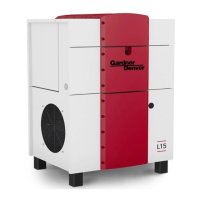Do you have a question about the Gardner Denver L30-45E and is the answer not in the manual?
Details about the compressor's design, quality, and environmental compliance.
Specifies authorized applications and user responsibilities for safe operation.
Emphasizes the necessity of proper, regular maintenance for longevity and performance.
Provides general guidance for safe, proper, and economical operation of the equipment.
Outlines essential safety measures and precautions for operating the machine.
Details risks, hazards, and necessary precautions when using compressed air.
Covers hazards specific to the compressor unit, electrical safety, and noise.
Addresses risks during lifting, transport, and relocation of the compressor.
Lists general safety precautions applicable to the work environment.
Highlights consequences of improper or deferred maintenance on safety.
Covers specific hazards and precautions when servicing the equipment.
Warns against unauthorized alterations, their risks, and warranty implications.
Explains the physical layout, components, and diagrams of the compressor unit.
Illustrates the functional diagram of the compressor's internal systems.
Describes the flow and function of the lubrication and oil separation system.
Details the path and process of compressed air generation and delivery.
Explains how the compressor's operations are managed, including starting and stopping.
Describes the manner of operation for the suction regulator in different modes.
Provides instructions and safety guidelines for moving the compressor unit.
Details the steps for properly setting up the compressor at its location.
Specifies requirements for ventilation, air flow, and ducting.
Guides on connecting the compressor outlet to the existing compressed-air system.
Explains the procedure for electrical hookup, safety, and checks.
Instructions for verifying the lubricant level before operation.
Step-by-step guide for initial startup and checks of the compressor.
Procedures for recommissioning after a period of disuse or shutdown.
Overview of the control panel interface, indicators, and messages.
Steps for regular startup, operation checks, and verification.
How to restart the unit safely after a fault has been rectified.
Proper procedures for normal shutdown of the unit using the stop button.
Guidelines for using the emergency shutdown button in critical situations.
Instructions for safely shutting down and preparing the unit for storage.
General advice on the importance and scope of regular maintenance.
Specific maintenance tasks and considerations for the electric motor.
Schedule outlining required service intervals, tasks, and check lists.
Detailed procedures, safety precautions, and intervals for changing compressor oil.
Steps for safely removing and replacing the oil filter cartridge.
How to replace the fine oil separator element, including safety.
Instructions for checking and replacing the air intake filter.
Information on checking, testing, and the importance of the pressure relief valve.
Guidelines for accessing and working with electrical terminals in the switch cabinet.
Checking and re-tightening of pneumatic, oil, and water circuit connections.
Routine cleaning and upkeep procedures for various compressor components.
Cleaning or replacing air intake filters and control cabinet inlet filters.
Specific notes on lubricants and maintenance for stationary compressor units.
Provides dimensional drawings, installation clearances, and connection points for the unit.
Details about the compressor's design, quality, and environmental compliance.
Specifies authorized applications and user responsibilities for safe operation.
Emphasizes the necessity of proper, regular maintenance for longevity and performance.
Provides general guidance for safe, proper, and economical operation of the equipment.
Outlines essential safety measures and precautions for operating the machine.
Details risks, hazards, and necessary precautions when using compressed air.
Covers hazards specific to the compressor unit, electrical safety, and noise.
Addresses risks during lifting, transport, and relocation of the compressor.
Lists general safety precautions applicable to the work environment.
Highlights consequences of improper or deferred maintenance on safety.
Covers specific hazards and precautions when servicing the equipment.
Warns against unauthorized alterations, their risks, and warranty implications.
Explains the physical layout, components, and diagrams of the compressor unit.
Illustrates the functional diagram of the compressor's internal systems.
Describes the flow and function of the lubrication and oil separation system.
Details the path and process of compressed air generation and delivery.
Explains how the compressor's operations are managed, including starting and stopping.
Describes the manner of operation for the suction regulator in different modes.
Provides instructions and safety guidelines for moving the compressor unit.
Details the steps for properly setting up the compressor at its location.
Specifies requirements for ventilation, air flow, and ducting.
Guides on connecting the compressor outlet to the existing compressed-air system.
Explains the procedure for electrical hookup, safety, and checks.
Instructions for verifying the lubricant level before operation.
Step-by-step guide for initial startup and checks of the compressor.
Procedures for recommissioning after a period of disuse or shutdown.
Overview of the control panel interface, indicators, and messages.
Steps for regular startup, operation checks, and verification.
How to restart the unit safely after a fault has been rectified.
Proper procedures for normal shutdown of the unit using the stop button.
Guidelines for using the emergency shutdown button in critical situations.
Instructions for safely shutting down and preparing the unit for storage.
General advice on the importance and scope of regular maintenance.
Specific maintenance tasks and considerations for the electric motor.
Schedule outlining required service intervals, tasks, and check lists.
Detailed procedures, safety precautions, and intervals for changing compressor oil.
Steps for safely removing and replacing the oil filter cartridge.
How to replace the fine oil separator element, including safety.
Instructions for checking and replacing the air intake filter.
Information on checking, testing, and the importance of the pressure relief valve.
Guidelines for accessing and working with electrical terminals in the switch cabinet.
Checking and re-tightening of pneumatic, oil, and water circuit connections.
Routine cleaning and upkeep procedures for various compressor components.
Cleaning or replacing air intake filters and control cabinet inlet filters.
Specific notes on lubricants and maintenance for stationary compressor units.
Provides dimensional drawings, installation clearances, and connection points for the unit.
| Model | L30-45E |
|---|---|
| Manufacturer | Gardner Denver |
| Type | Rotary Screw Air Compressor |
| Drive Type | Direct Drive |
| Phase | 3 |
| Maximum Pressure | 175 PSI |
| Voltage | 208-230/460 V (depending on model) |











